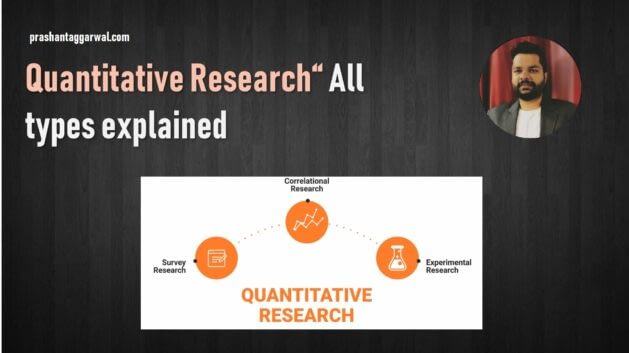This post covers the different types of quantitative research design.
Quantitative Research Types
Quantitative Research – Experimental
- True experimental
-
- True experimental research aims to determine causal relationships among variables, and it relies on statistical analysis to approve or disprove a hypothesis. It is also worth noting that true experimental research is considered the most accurate type of experimental design.
- It may be conducted with or without a pre-test, and it always involves a control group and a test group.
- Other characteristics include variable manipulation, Random selection of participants. It is always conducted in a controlled setting, and intervention is always present.
- For example, a researcher wants to do quantitative research and determine the effects of classical music on students’ academic performance. Since this is true experimental research, it must have at least two groups. One would be the control group, and the other one would be the test or experimental.
- In the control group, everything is held constant or regular, which means that there would be no intervention, which means there is no music or no music played in their classes.
- While in the test or experimental group, there is the presence of intervention which is classical music. This intervention can further be manipulated with variables such as frequency and music volume.
- At the end of the study, the researchers assess the control without music. And test or experiment with music by looking at their academic performance.
- Based on this example, we conclude that played classical music was studying as a positive effect on the student’s grades.
-
- Quasi-experimental
-
- Similar to true experimental research, this type of research aims to determine causal relationships among variables.
- It bears a resemblance to true experimental research but different because participants are not randomly assigned in this type of research. It involves the conduct of the pre-test and post-test.
- Furthermore, other characteristics of the Quasi-experimental research involved variable manipulation. It’s also conducted in a controlled setting, and that the intervention is also present.
- For example, a teacher wants to do quantitative research and test a reading intervention program to aid students with a low level of comprehension. Since this is Quasi-experimental research, this study would usually start with the pre-test.
- The pre-test would be a reading comprehension test that would help determine who among the students has passed and who has failed.
- Recognizing the students to a field is essential as these students will be considered participants for the reading intervention program.
- Once the participants have been identified, they shall undergo their reading intervention program, which can further manipulate them through the duration of the program, the schedule given to the students, the reading activities given, and the teaching strategy that is used.
- After undergoing intervention, we now proceed with the post-test, which is another reading comprehension test. The students who spilled their reading comprehension tests given before would have experienced the reading intervention program and will then be given another reading comprehension test to determine whether they will pass or still fail.
- If they have passed, we can conclude that the reading intervention program effectively improves the reading comprehension of students with low-level understanding.
-
Similarities between True and Quasi-experimental design of quantitative research
- Both are used to determine causal relationships
- Both have interventions
- Involves manipulation of variables
- both are conducted in a controlled setting
Differences between True and Quasi-experimental design of quantitative research
- There is a random selection of participants in True experimental, but in Quasi, the selection is not random.
- True experimental may be conducted with or without a pre-test, while Quasi-experimental research involves pre-test and post-test.
- True experimental research involves a test group and a control group, while Quasi-experimental research does not have any control group.
Quantitative Research – Not experimental
- According to Purpose
- Surveys
-
-
- Survey research gathers evidence on people’s knowledge, opinions, attitudes, and values on various issues and concerns.
- The survey research makes use of questionnaires, interviews, and surveys. Also, in survey research, the variables are not controlled or manipulated, and no intervention is applied.
- For example – A researcher wants to survey the preference of individuals towards mass testing. What he does is identify the participants and give them the questionnaires that they will answer.
- Again, there is no intervention in survey research because the researcher would only wait for the respondents to give out their answers. Also, in survey research, researchers focus on recording and tallying the responses, analyzing and interpreting that data.
- From these detailed data, he comes up with conclusions. The data that the researcher was able to identify is that those who answered yes are 75 percent, while those who answered No are 25 percent. From this detailed data, the researcher then concludes that the majority, or 75 percent or therefore Group A, favors mass testing.
-
-
- Correlational Research
-
-
- The correlational research seeks to interpret the degree of relationship between 2 or more variables using statistical data. Similar to the survey research, the variables are not controlled or manipulated, and no intervention is applied here.
- It is also worth noting that while correlational research aims to interpret the degree of relationship between variables, it does not seek to determine cause and effect relationships.
- For example, the researcher wants to do quantitative research to determine the influence of online gaming on students’ critical thinking.
-
- In the study, he hypothesized that there is no significant relationship between online gaming and critical thinking.
- To conduct this detailed research, the researcher needs to find online gamers who will agree to become participants in our study. Again in the correlational analysis, there is no intervention because the responsibilities of researchers focused primarily on gathering the needed data, applying the correct statistical treatment, analyzing and interpreting the treated data, and rejecting or accepting the hypothesis.
- Now going back to our online universe, these participants are then given instruments that would assess their online gaming habits and their critical thinking level.
- From there, we will give the appropriate statistical treatment to determine whether there’s a relationship between online gaming and critical thinking and whether an increase in online gaming would increase critical thinking or vice versa.
-
-
-
- Surveys
- According to time
- Cross-sectional research
-
-
- Cross-sectional research involves gathering data at a single point in time. It focuses on the same set of variables, after which comparisons are made across variables of interest.
- For example – A researcher once identified the spending trends between men and women in their thirties. From this detailed research, the findings came that women tend to spend more money than men.
- The researchers then take this particular data in cross-sectional research and compare it with other variables like age brackets. He will then compare whether there are similarities or differences in terms of the trends and results.
-
-
- Longitudinal
-
-
- In longitudinal research, the data is collected at multiple points in time. A researcher collects data from the present and again in the future to compare datasets.
- For example – A study on the effects of antiretroviral medicines as a maintenance drug for HIV-positive patients needs to be done. The participants for this particular study are individuals who tested positive for HIV.
- At the start of the longitudinal research, their HIV viral load is taken and reported before they are given the medicines. After which their viral load is monitored on a specific schedule to determine how the drugs are working.
-
- Based on this particular example, you could say that it takes quite a long time before this specific study is finished, hence longitudinal.
-
- Cross-sectional research
As researchers, it is essential to understand the Quantitative research types. This knowledge will help us to determine the best research design for the research objectives.
In this post, I’ve covered the basics of Quantitative research types. If you found my post helpful, then do share it with your friends and colleagues. If you have any feedback/questions, you may leave a comment below.


